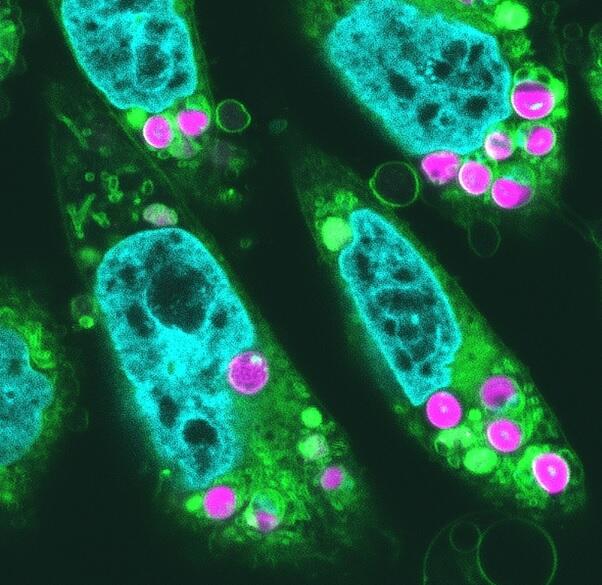A research group led by Professor Sachihiro Matsunaga of the Graduate School of Frontier Sciences at the University of Tokyo, Senior Technical Scientist Kiminori Toyooka of the RIKEN Center for Sustainable Resource Science, Professor Tatsuya Tomo of the Institute of Arts and Sciences at Tokyo University of Science and Professor Kintake Sonoike of the Faculty of Education and Integrated Arts and Sciences at Waseda University has announced that they succeeded in incorporating chloroplasts from Cyanidioschyzon merolae (schyzon; an alga) in cultured animal cells and detecting electron transfer in photosynthetic reactions in the cultured animal cells. By examining the culture medium conditions, they successfully incorporated chloroplasts in intact cells via phagocytosis. The chloroplasts incorporated in the animal cells maintained photosynthetic activity for at least 2 days. This achievement is expected to lead to the use of light energy for cell culture and other applications. The results were published in the October 31 issue of the international journal Proceedings of the Japan Academy, Series B, Physical and Biological Sciences.

Provided by Professor Sachihiro Matsunaga, the University of Tokyo
Chloroplasts are cell organelles that carry out photosynthesis in plants and are considered to have appeared when cyanobacteria (blue-green algae) evolved into algae through symbiosis with animal cells 1.2-1.6 billion years ago. Studies on imparting photosynthetic function to animal cells through the incorporation of chloroplasts were conducted from the 1970s to the 1980s but were discontinued because of degradation of the incorporated chloroplasts.
Meanwhile, expectations for photosynthesis as a clean energy source have increased in recent years. The realization of photosynthesis in animal cells is eagerly awaited to reduce the cost of cell culture and other processes and to reduce carbon dioxide emissions. There is also a species of nudibranch that takes up only the chloroplasts in their diet to perform photosynthesis. The research group has been aiming for the creation of "planimal cells," which are animal cells capable of photosynthesis.
In this study, the group succeeded in isolating chloroplasts with photosynthetic activity from the primitive alga schyzon, while maintaining their photosynthetic function. Reasons for selecting schyzon, which inhabits hot springs in Italy, included the temperature conditions for culture that are similar to those for cultured animal cells, and the number of genes in its chloroplast DNA (208) that is about twice as many as those in typical chloroplast DNA. The research group also confirmed that isolated chloroplasts had the intact inner structure and maintained photosynthetic activity for approximately 2 weeks.
Next, they investigated a method for incorporation of the isolated chloroplasts into CHO cells, which are cultured animal cells from hamsters for general research. The research group identified the culture medium conditions for efficient phagocytosis by CHO cells and developed a method for incorporating the chloroplasts in intact animal cells through co-cultivation. Previously, chloroplasts were incorporated in cells by making holes in the cell membrane. The efficiency of phagocytosis by CHO cells was also low in general culture conditions.
In this study, the research group succeeded in incorporating an average of 2-3 chloroplasts and a maximum of 45 chloroplasts per CHO cell. Super-resolution microscopy was used to observe the process of chloroplast incorporation from multiple angles. They also confirmed that chloroplasts maintained their structure for at least 2 days and degraded after 6 days. When these cells were observed, the incorporated chloroplasts appeared to be moving to the vicinity of the nuclear membrane or incorporated into the mitochondria.
To investigate whether these chloroplasts maintained photosynthetic activity, the electron transfer (PSII activity) in the incorporated chloroplasts was examined by pulse amplitude modulation chlorophyll fluorometry. PSII activity was confirmed to be maintained up to day 4 but lost by day 6. Presumably oxygen is produced.
Matsunaga said, "We believe that oxygen is probably formed because electron transfer is occurring. We are currently working on a study to prove this. We should also develop a system to continue photosynthesis for longer periods of time in animal cells. If 'planimal cells' are put into practice in the future, the problem of oxygen depletion in inner layers in multilayer cell culture systems of, for example, organoids, artificial organs, and cultured meat may be mitigated when they are produced, which promotes their growth."
Journal Information
Publication: Proceedings of the Japan Academy, Series B, Physical and Biological Sciences
Title: Incorporation of photosynthetically active algal chloroplasts in cultured mammalian cells towards photosynthesis in animals
DOI: 10.2183/pjab.100.035
This article has been translated by JST with permission from The Science News Ltd. (https://sci-news.co.jp/). Unauthorized reproduction of the article and photographs is prohibited.




